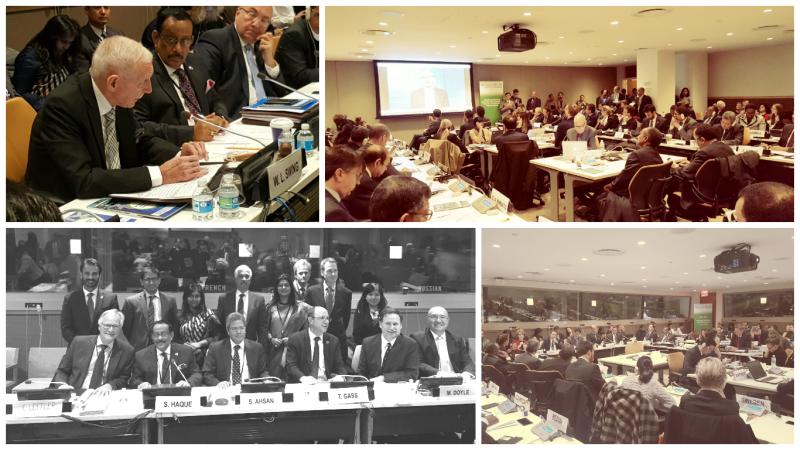

GFMD New York Dialogue - Building the pillars of the Global Compact
The New York Declaration that followed the 19th September Summit was an important milestone in the future of governance of international migration, in a context marked by mixed flows of movements, an unprecedented scale of large movement refugees and migrants, dramatic images and fear-driven rhetoric. How can member states design a Global Compact to facilitate mobility which will be both deliverable and balanced? What are the possible commitments by the different stakeholders to create a comprehensive global framework and follow-up mechanism? Moreover, how can the GFMD, as an informal space guaranteeing exchange of ideas and among other inter-governmental process, engage actively in the construction and the definition of the Compact?
These were the guiding questions addressed before a crowded audience attending the GFMD Dialogue on the Global Migration Compact, hosted by the Government of Bangladesh, GFMD 2016 Chair, at the UN Headquarters in New York on November 14 2016. High level speakers and panelists shared their perspectives in an informal and thought-provoking setting and offered many useful insights, with the objectives of fueling with ideas the process of developing the Global Compact. The full day event focused on the social, economic and legal aspects of the Global Compact.
In the introductory remarks, speakers mentioned political commitments and shared responsibility as key elements that will ensure the success of the Compact. The need for a common and inclusive framework to govern migration was reiterated by the GMFD 2017 Co-Chairs, Germany and Morocco, respectfully represented by Mr. Sönke Lorenz and Mr. Ahmed Skim. The New York Declaration has opened a unique chance to move forward and every stakeholder has its own role and potential to contribute to the Compact. More precisely, the role of member states and more specifically of state to state cooperation was pointed out by Mr. Lorenz, while the regional processes were highlighted by Mr. Skim and Ambassador Mehmet Samsar from Turkey. Moreover, the responsibility of the UN in the follow up process was reaffirmed by Ms. Nakamitsu, from UNDP and Mr. Eliasson, UN Deputy Secretary General. Above all, moving from words to actionable and meaningful outcomes would be paramount. In the words of IOM Director General Ambassador William Lacy Swing, the Global Compact should be comprehensive (moving beyond the short term measures), coherent (taking note of the existing architecture), cooperative (through the involvement of all) and an exercise of courage (political will).
What social issues should the Global Compact address? In the first session, panelists and participants underlined that understanding migration – a complex phenomenon that cannot be reduced to one dimension- is crucial. In other words, understanding the decision to migrate, the social interaction between migrants and host societies, the repercussions in the family and the necessity to protect the health and the rights of migrants, as well as recognizing the increasing role of multiple identities have to be taken into account. Mr. Enrico Fos and Ms. Samantha Jayasuriya illustrated these concerns by sharing the perspective of their respective countries, Philippines and Sri Lanka. The Civil Society’s voice was also echoed in the room through the intervention of Ms. Eva Sandis, from the NGO Committee on Migration, who stressed the need for concrete deliverables and monitored implementation, which could make a difference for the migrants on the ground.
The second session highlighted the need to understand the economics of migration. The key note presentation given by Dilip Ratha of the World Bank offered significant insights on the drivers and realities of migration. The session pointed out the magnitude of South-South migration and emphasized the need for human mobility through a comprehensive human-centric approach. Going forward, the Global Compact should address income gaps, abusive employers and trafficking, and the creation of opportunities for all.
Following Mr. Ryszard Cholewinski’s inclusive presentation on the legal aspects of the Compact, the question of whether it would be binding or non-binding was repeatedly raised. The general sense was that it would be up to the Member States to decide the legal format of the Compact, and the modalities of the negotiation process that would lead to the 2018 intergovernmental conference on international migration. In that perspective, GFMD could be a useful space for informal discussions.
To summarize, how could the Global Compact look like? Prof. Doyle, from the University of Columbia, offered some insightful perspectives on how to build what he called a “realistic utopia” and a legal framework for migration, covering the wide spectrum of human mobility, from tourists to refugees. GFMD 2016 Chair Ambassador Haque held the view that there are three possible options – the Compact could take the form of 1) a binding Convention; 2) a series of guiding principles or guidelines and commitments with operational deliverables, targets and monitoring framework; in a way similar to the SGDs; or 3) could be similar to the Paris agreement, which is partially binding and partially mandatory. Sharing the views of the EU and its experience in the partnership framework, Mr. Christian Leffler emphasized the need to base the compact on the existing guidelines on human rights, migration and refugees and should cover a vast array of issues, such as protection of the rights of migrants or migrants in vulnerable situations. As questions persisted as to the nature of the Compact, Mr. Thomas Gass, Assistant Secretary General, UN DESA reminded the participants that the only certainty is the necessity to move forward. Among the building blocks of the Compact, the Global Forum on Migration and Development will be part of the next step.